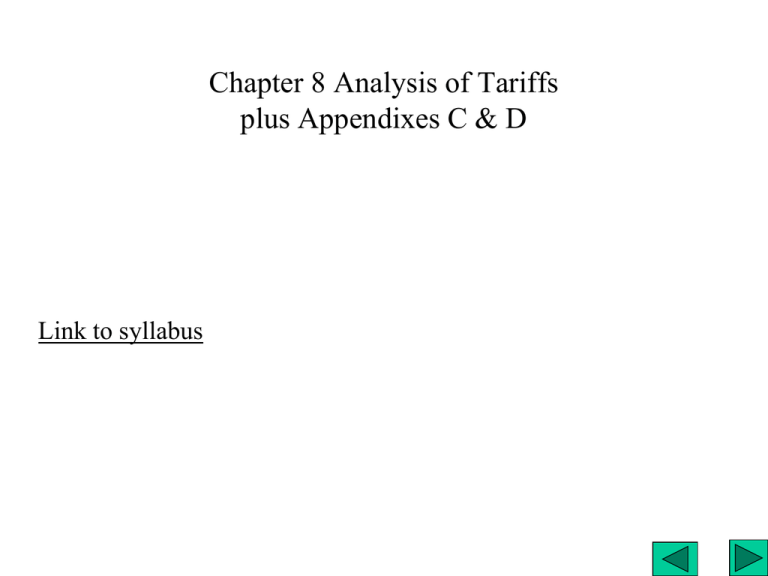
Chapter 8 Analysis of Tariffs
plus Appendixes C & D
Link to syllabus
Figure 8.2 page 147
The effect of a tariff on producers
Figure 8.3 page 150
Effect of a tariff on consumers
Figure 8.4 page 152. The net national loss from a tariff
TM-37
U.S. tariff rates (McBrue)
U.S. Tariff Rates, 1860-1999
McGraw-Hill/Irwin
© 2002 The McGraw-Hill Companies, Inc., All Rights Reserved.
Page 106
McC/Brue
text
Effective Rate of Protection
Effective rate of protection is an analysis of the protection given to an
industry, taking into account not only the direct effect of tariffs helping
that industry, but also the indirect impact of the nation’s tariffs on
inputs into that industry.
Effective rate of protection = (v’-v)/v [x100], where v is international
value added, and v’ is the domestic value added.
Effective rate of protection, page 155
So ERP = (v’ – v)/v = (99 – 80)/80 = 23.8%
Example of ERP calculations
Consider the industry that produces computers. Suppose there is one
purchased input, called chips. Both computers and chips can be imported
Suppose the world price of computers is $1,500/unit, and that of chips
is $600, leaving $900/unit as the domestic value added.
If there is a 20% tariff on computers, and free trade in chips, then the
price of the computer will rise to $1,800, allowing value added to rise to
$1,200. ERP = (1200-900)/900 = 33%.
If there is no tariff on computers, but a 25% tariff on chips, then chips
Will cost $750, while the price of the finished computer stays at $1500,
Leading to a reduction in domestic value added to $750, and
ERP=(750-900)/900 = - 16%.
If there is a 10% tariff on computers, and 33% on chips, then ERP =-6%
If there is 30% tariff on computers, and 30% on chips, then ERP = 30%.
Figure 4.4 Specialization and Trade and Tariffs
(from Thompson: a different textbook. Not covered in Pugel)
Autarky: production and consumption
at A.
Free trade, production at P, consumption
at T. Country exports S (services).
With a tariff, production moves to P’
and consumption is at T’.
Assuming world prices have not changed,
T’ must correspond to a lower level
of community indifference than T.
Figure 8.5 page 158
A large country imposes a small tariff
Fig. 8.5 p. 160. A Large Country Imposes a Small Tariff
Figure 8.6 page 16. Nationally optimal tariff
Page 676
Figure C.1
(Appendix C)
Derivation of
Offer Curve
Figure D.1 p. 676. How a slight tariff can be
beneficial to a large country
Figure D.2 p. 678. Optimal Tariff
Problem #5 page 162.
World Price
Tariff
Domestic Price
Domestic Consumption
Domestic production
Imports
w/tariff
$0.10 / lb.
$ 0.02/lb
$0.12/lb
20
8
12
Calculate:
a) Domestic consumers’ gain from removing the tariff
b) domestic producers’ loss from removing the tariff
c) The government tariff revenue loss
d) Net effect on national well-being
w/o tariff
$0.10/lb
0
$ 0.10/lb
22
6
16





